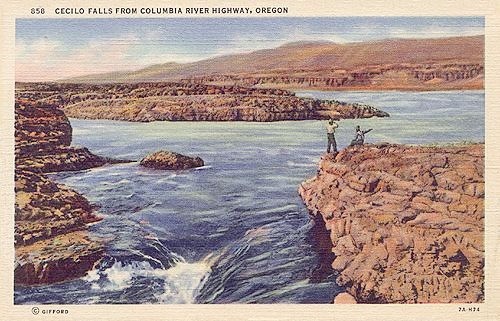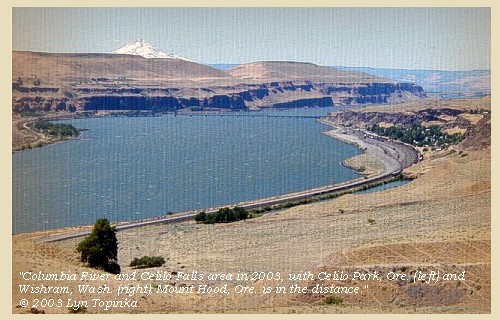The Volcanoes of
Lewis and Clark
Lewis and Clark
|
October 23, 1805 "Great Falls of the Columbia" - The Portage Continues |
|
Home
The Volcanoes of Lewis and Clark Map of the Journey Volcanoes, Basalt Plateaus, Major Rivers, etc. The Volcanoes Mount Adams, Mount Hood, Mount Jefferson, Mount Rainier, and Mount St. Helens CALENDAR of the Journey October 1805 to June 1806 Along the Journey Pacific Northwest Maps - Columbia River, Volcanoes, Flood Basalts, Missoula Floods, Geology, etc. The Corps of Discovery The Journey of Lewis and Clark About the Reference Materials The Journals, Biddle/Allen, DeVoto, Gass, Moulton, Topo Maps, and others USGS Lewis and Clark Links Links to USGS Websites highlighting the Lewis and Clark Journey Resources Publications Referenced and Websites Visited |
PREVIOUS
October 22 "Great Falls of the Columbia" Maryhill to Celilo |
October 23
"Great Falls of the Columbia" The Portage Continues "Great Falls of the Columbia", Celilo Falls and Wishram (Washington) |
CONTINUE
October 24 The Dalles, "Short Narrows" |
|
To the Pacific - October 1805
"Great Falls of the Columbia" - The Portage Continues |
| Lewis and Clark's camp of October 22 and 23, 1805, was on the Washington side of the Columbia River, downstream of Wishram, Washington, and across from Oregon's Celilo Park. The men are portaging across the "Great Falls of the Columbia" (Celilo Falls), an area now under the waters of Lake Celilo. |
| Wednesday, October 23, 1805 |
| Having ascertained from the Indians, and by actual examination [Celilo Falls, "Great Falls of the Columbia"], the best mode of bringing down the canoes, it was found necessary, as the river was divided into several narrow channels, by rocks and islands, to follow the route adopted by the Indians themselves. This operation captain Clarke began this morning, and after crossing to the other side of the river, hauled the canoes over a point of land, so as to avoid a perpendicular fall of twenty feet. At the distance of four hundred and fifty-seven yards we reached the water, and embarked at a place where a long rocky island [???] compresses the channel of the river within the space of a hundred and fifty yards, so as to form nearly a semicircle. On leaving this rocky island [???] the channel is somewhat wider, but a second and much larger island [???] of hard black rock, still divides it from the main stream, while on the left shore it is closely bordered by perpendicular rocks. Having descended in this way for a mile, we reached a pitch of the river, which being divided by two large rocks, descends with great rapidity down a fall eight feet in height: as the boats could not be navigated down this steep descent, we were obliged to land and let them down as slowly as possible by strong ropes of elk skin, which we had prepared for the purpose. They all passed in safety except one, which being loosed by the breaking of the ropes, was driven down, but was recovered by the Indians below. |
| "... a fine morning, I with the greater part of the men Crossed in the Canoes to opposit Side above the falls and hauled them across the portage of 457 yards which is on the Lard. Side and certainly the best side to pass the canoes I then decended through a narrow chanel of about 150 yards wide forming a kind of half circle in it course of a mile to a pitch of 8 feet in which the chanel is divided by 2 large rocks at this place we were obliged to let the Canoes down by Strong ropes I accomplished this necessary business and landed Safe with all the Canoes at our Camp below the falls by 3 oClock P.M. ... The Altitude of this day 66o 27' 30" gave for Latd. 45o 42' 57 3/10 N. ..." [Clark, October 23, 1805] |
| "... The whole height of the falls is 37 feet 8 inches, in a distance of 1200 yards. ..." [Gass, October 23, 1805] |
| With this rapid ends the first pitch of the great falls [Celilo Falls], which is not great in point of height, and remarkable only for the singular manner in which the rocks have divided its channel. From the marks every where perceivable at the falls, it is obvious that in high floods, which must be in the spring, the water below the falls rises nearly to a level with that above them. Of this rise, which is occasioned by some obstructions which we do not as yet know, the salmon must avail themselves to pass up the river in such multitudes, that that fish is almost the only one caught in great abundance above the falls; but below that place, we observe the salmon trout, and the heads of a species of trout smaller than the salmon trout, which is in great quantities, and which they are now burying to be used as their winter food. ...... |
| Mount Hood, Oregon is visible along this stretch of the Columbia River. |
| About three o'clock we reached the lower camp, but our joy at having accomplished this object was somewhat diminished, by the perscution of a new acquaintance. On reaching the upper point of the portage, we found that the Indians had been encamped there not long since, and had left behind them multitudes of fleas. These sagacious animals were so pleased to exchange the straw and fish skins, in which they had been living, for some better residence, that we were soon covered with them, and during the portage the men were obliged to strip to the skin, in order to brush them from their bodies. They were not, however, so easily dislodged from our clothes, and accompanied us in great numbers to our camp. ...... |
|
|
|
The Camp - October 22 and 23, 1805:
Downstream of Wishram, Washington, across from Oregon's Celilo Park. |
| Home | Previous | Continue |
If you have questions or comments please contact: GS-CVO-WEB@usgs.gov
June/July 2004, Lyn Topinka
The Volcanoes of Lewis and Clark Home Page | CVO Home Page
















